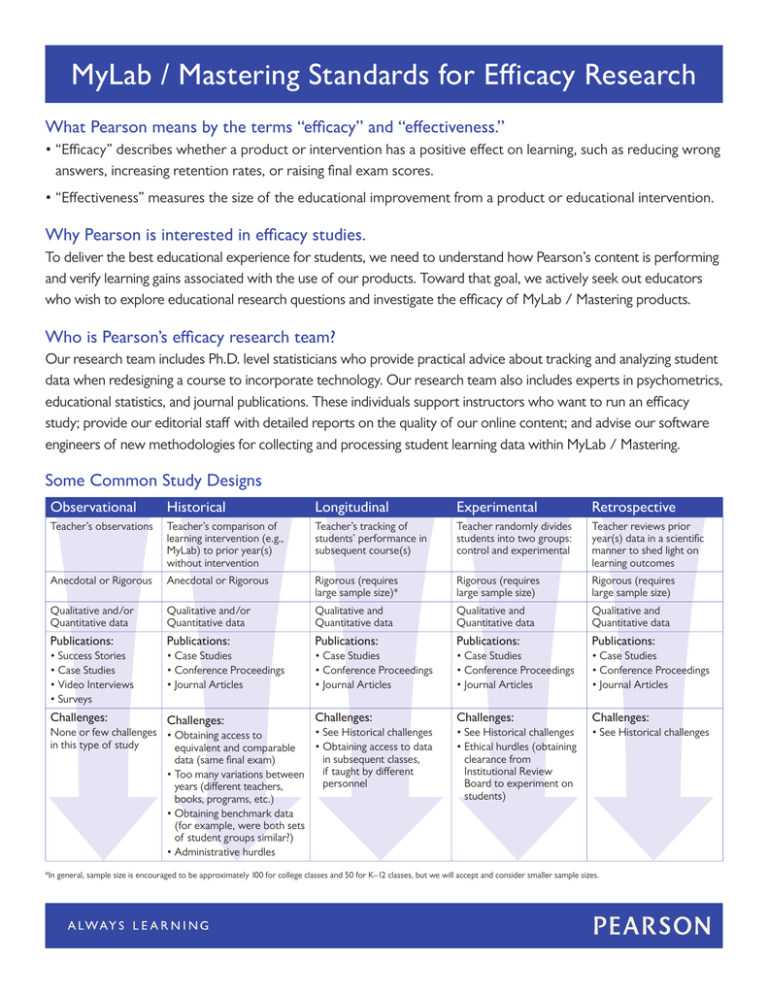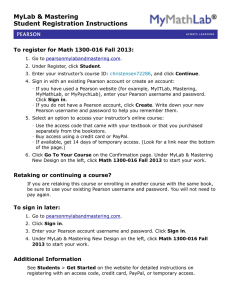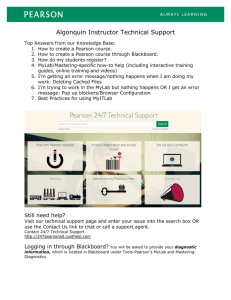MyLab / Mastering Standards for Efficacy Research
advertisement

MyLab / Mastering Standards for Efficacy Research What Pearson means by the terms “efficacy” and “effectiveness.” •“Efficacy” describes whether a product or intervention has a positive effect on learning, such as reducing wrong answers, increasing retention rates, or raising final exam scores. • “Effectiveness” measures the size of the educational improvement from a product or educational intervention. Why Pearson is interested in efficacy studies. To deliver the best educational experience for students, we need to understand how Pearson’s content is performing and verify learning gains associated with the use of our products. Toward that goal, we actively seek out educators who wish to explore educational research questions and investigate the efficacy of MyLab / Mastering products. Who is Pearson’s efficacy research team? Our research team includes Ph.D. level statisticians who provide practical advice about tracking and analyzing student data when redesigning a course to incorporate technology. Our research team also includes experts in psychometrics, educational statistics, and journal publications. These individuals support instructors who want to run an efficacy study; provide our editorial staff with detailed reports on the quality of our online content; and advise our software engineers of new methodologies for collecting and processing student learning data within MyLab / Mastering. Some Common Study Designs Observational Historical Longitudinal Experimental Retrospective Teacher’s observations Teacher’s comparison of learning intervention (e.g., MyLab) to prior year(s) without intervention Teacher’s tracking of students’ performance in subsequent course(s) Teacher randomly divides students into two groups: control and experimental Teacher reviews prior year(s) data in a scientific manner to shed light on learning outcomes Anecdotal or Rigorous Anecdotal or Rigorous Rigorous (requires large sample size)* Rigorous (requires large sample size) Rigorous (requires large sample size) Qualitative and/or Quantitative data Qualitative and/or Quantitative data Qualitative and Quantitative data Qualitative and Quantitative data Qualitative and Quantitative data Publications: Publications: Publications: Publications: Publications: • Success Stories • Case Studies • Video Interviews • Surveys • Case Studies • Conference Proceedings • Journal Articles • Case Studies • Conference Proceedings • Journal Articles • Case Studies • Conference Proceedings • Journal Articles • Case Studies • Conference Proceedings • Journal Articles Challenges: Challenges: Challenges: Challenges: Challenges: • See Historical challenges • Ethical hurdles (obtaining clearance from Institutional Review Board to experiment on students) • See Historical challenges None or few challenges • Obtaining access to • See Historical challenges in this type of study •O btaining access to data equivalent and comparable in subsequent classes, data (same final exam) if taught by different • Too many variations between personnel years (different teachers, books, programs, etc.) • Obtaining benchmark data (for example, were both sets of student groups similar?) • Administrative hurdles *In general, sample size is encouraged to be approximately 100 for college classes and 50 for K–12 classes, but we will accept and consider smaller sample sizes. How Pearson and instructors work together. Every research project is unique. The process takes time—generally a semester or longer. Below is a typical flow chart of the process. Set Goal Design Course Evaluate Resources Select Measurement Tools Implement Course Prepare Data Analyze Data Interpret Data Adjust Course How Pearson can help instructors get started. Pearson can provide templates, guidelines, checklists, and samples on course redesign, efficacy studies, data collection, and more. In order to maintain objectivity, Pearson does not pay for data or participation in efficacy studies. Research Standards Pearson adheres to the SIIA guidelines for evaluating educational technology products. The key guidelines are: • Ask the Right Question • Support the Implementation of the Product or Service • Plan a Study of Sufficient Size and Duration to Demonstrate an Effect • Plan for Plausible Causal Claims • Avoid (the Appearance of ) Conflicts of Interest • Provide a Comprehensive and Detailed Research Report • Make the Research Findings Widely Available • Accurately Translate Research for Customers Contact your Pearson Representative for more information.

